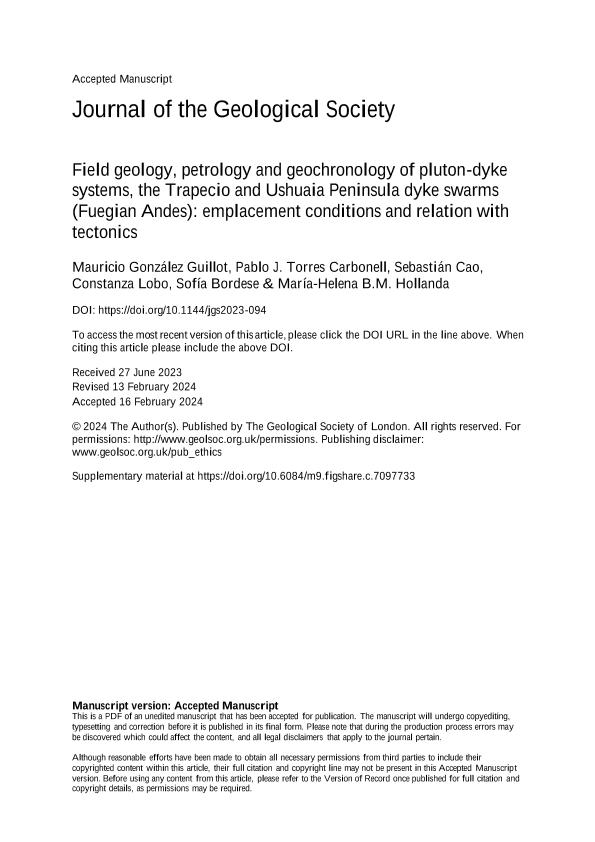Artículo
Field geology, petrology and geochronology of pluton-dyke systems, the Trapecio and Ushuaia Peninsula dyke swarms (Fuegian Andes): Emplacement conditions and relation with tectonics
Gonzalez Guillot, Mauricio Alberto ; Torres Carbonell, Pablo Juan
; Torres Carbonell, Pablo Juan ; Cao, Sebastián José
; Cao, Sebastián José ; Lobo, Constanza
; Lobo, Constanza ; Bordese, Sofía; Hollanda, María Helena B.M.
; Bordese, Sofía; Hollanda, María Helena B.M.
 ; Torres Carbonell, Pablo Juan
; Torres Carbonell, Pablo Juan ; Cao, Sebastián José
; Cao, Sebastián José ; Lobo, Constanza
; Lobo, Constanza ; Bordese, Sofía; Hollanda, María Helena B.M.
; Bordese, Sofía; Hollanda, María Helena B.M.
Fecha de publicación:
03/2024
Editorial:
Geological Society Publications House
Revista:
Journal of the Geological Society
ISSN:
0016-7649
Idioma:
Inglés
Tipo de recurso:
Artículo publicado
Clasificación temática:
Resumen
We report the field geology, petrography, geochemistry and geochronology data for two dyke swarms in the Fuegian Andes, with the aim of correlating them with known suites and of improving the knowledge on the magmatism of the Late Cretaceous rear-arc and its relation with ductile deformation. We also provide keys for correlation based on amphibole K2O content. The Trapecio dyke swarm is mildly alkaline and ferriferous, with a zircon U-Pb age of 75 Ma; thus it belongs to the Fuegian Potassic Magmatism (78-68 Ma). The Ushuaia Peninsula dyke swarm, also known as Ushuaia Peninsula Andesites (UPA), was shown to be high-K calc-alkaline and magnesian. New radiometric ages gave 87-86 Ma. While the UPA dyke swarm exhibits foliation associated with ductile deformation, the Trapecio dyke swarm is post-kinematic and reveals emplacement controlled by the slaty cleavage in the metapelite host. Field and geophysical evidence suggest both swarms overlie small upper-crustal plutons, mostly buried. The variable composition of dykes suggests a protracted history of dyke injection, mostly fed from deeper reservoirs. Contact metamorphism around both pluton-dyke systems is very weak. By comparison with adjacent plutons we argue that the main variables controlling aureole development are small magma volumes and low injection rates.
Palabras clave:
Fuegian Andes
,
Ushuaia
Archivos asociados
Licencia
Identificadores
Colecciones
Articulos(CADIC)
Articulos de CENTRO AUSTRAL DE INVESTIGACIONES CIENTIFICAS
Articulos de CENTRO AUSTRAL DE INVESTIGACIONES CIENTIFICAS
Citación
Gonzalez Guillot, Mauricio Alberto; Torres Carbonell, Pablo Juan; Cao, Sebastián José; Lobo, Constanza; Bordese, Sofía; et al.; Field geology, petrology and geochronology of pluton-dyke systems, the Trapecio and Ushuaia Peninsula dyke swarms (Fuegian Andes): Emplacement conditions and relation with tectonics; Geological Society Publications House; Journal of the Geological Society; 181; 3; 3-2024; 1-44
Compartir
Altmétricas



